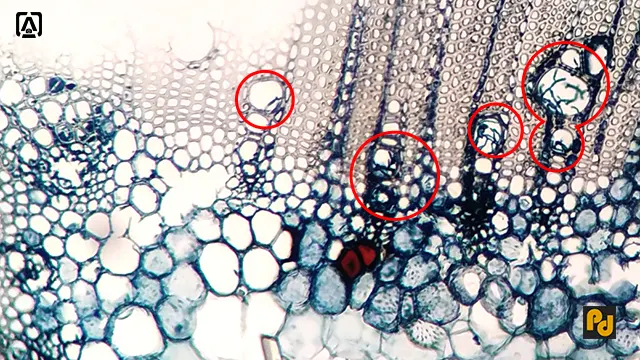Wilt disease of pigeon pea
Host: Cajanus cajan (pigeon pea/Arhar)
Pathogen: Fusarium oxysporum f. udum Butler
Pathogen: Fusarium oxysporum f. udum Butler
Distribution
Wilt disease of pigeon pea was reported from Bihar state in India in 1906 by Butler. The disease is prevalent throughout the pigeon pea-growing regions of the world, including India, Kenya, Malawi, Tanzania, and Mozambique. Wilt disease can cause 30–100% loss in grain yield (Pandey et al., 2013).
Symptoms
 |
| Photograph showing healthy (green) ans wilted (brown) plant of pigeon pea. Base of infected stem turns brown (in inset). |
The disease usually occurs sporadically in the fields and infection is seen in few plants. Infection starts at the seedling stage. In infected plants leaves become pale, loose their turgidity and finally start drooping down. Infected plants show gradual wilting from bottom to top. Wilting occurs as a result of plugging of xylem vessels with fungal structures, which checks the water uptake. Infected stems show vascular browning. In severe infection entire plant wilts or dies within a days or two. Base of the infected stem (just above the soil) turns brown and scaly.
Causal organism
Wilt disease of pigeon pea is caused by Fusarium oxysporum f. udum. Its perfect stage is recognized as Gibberella indica. The fungus produces macroconidia, microconidia, and chlamydospores.
 |
| Transverse section of infected root of pigeon pea showing xylem vessel plugged by mycelium and conidial mass of Fusarium oxysporum udum (in red circles). |
Macroconidia are produced successively at the end of short simple or
clustered conidiophores and remain bound in a drop of liquid. Macroconidia are fusiform, multi-celled by transverse septa, with a characteristic foot-shaped basal cell and a pointed to whip-like apical cell. Microconidia are bacteria-like, white to salmon pink in color, borne on shorter condiophores, and become free as soon as objected. Fungus produces chlamydospores in nitrogen deprived culture medium.
Disease cycle and epidemiology
Disease is soil-born. The pathogen can survive in infected debris in soils as a saprophyte for up to 3 years. On getting host, fungus enters through finer roots and causes primary infection. Disease is monocyclic as the infected plants wilt and die.
Control measures
The pathogen is soil-borne. Therefore, only chemical control is ineffective. The disease can by controlled by applying more than one method under integrated disease management (IDM).
- Integrated disease management (IDM) approach can be applied with the combination carbendazim seed treatment @ 2 g/kg of seeds + Trichoderma viride @ 2.5 kg/ha and farmyard manure @ 50 kg/ha (Prasad et al., 2012).
- Biological control by seed dressing by Pantoea dispersa reduces wilt incidence by 47% (Maisuria et al., 2008).
- Long duration (more than 3 years) of crop rotation reduces the chance of infection.
Sources
- Pande SU, Sharma MA, Guvvala GO. An updated review of biology, pathogenicity, epidemiology and management of wilt disease of pigeonpea (Cajanus cajan (L.) Millsp.). Journal of Food Legumes. 2013;26(1-2):1-4.
- Prasad, P.S., Muhammad, S., Mahesh, M. and Kumar, G.N.V., 2012. Management of pigeonpea wilt caused by Fusarium udum Butler through integrated approaches. Journal of Biological Control, 26(4), pp.361-367.
- Maisuria, V.B., Gohel, V., Mehta, A.N., Patel, R.R. and Chhatpar, H.S., 2008. Biological control of Fusarium wilt of pigeonpea by Pantoea dispersa, a field assessment. Annals of microbiology, 58(3), pp.411-419. https://annalsmicrobiology.biomedcentral.com/articles/10.1007/BF03175536
Content first created on 16-03-2021
last updated on 06-10-2024
last updated on 06-10-2024





0 Comments
Leave your comments here.